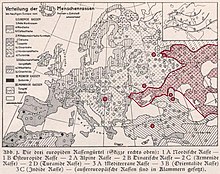| Revision as of 15:38, 10 October 2023 editRsk6400 (talk | contribs)Extended confirmed users15,278 edits Undid revision 1179448239 by 147.30.25.116 (talk) poorly done, not relevantTags: Undo Mobile edit Mobile web edit Advanced mobile edit Disambiguation links added← Previous edit | Revision as of 15:39, 10 October 2023 edit undoRsk6400 (talk | contribs)Extended confirmed users15,278 edits Undid revision 1179447537 by 147.30.25.116 (talk) poorly done, not relevantTags: Undo Mobile edit Mobile web edit Advanced mobile editNext edit → | ||
| Line 4: | Line 4: | ||
| == History == | == History == | ||
| Description: | |||
| Short-headed, high-skulled type native to the steppes of Central Asia. Medium tall, often with slender bodies, an oval head and high mid face, and narrow eye lid fissure. Hairiness strong, eyebrows sometimes united. Probably originated in Altai, Tian Shan, and around the Baikal Lake. Was pushed back and replaced in many areas by the Mongol expansion. The highest concentrations today are found in ], ], ], and ] with the Pamirids (East Pamirid, Central Pamirid, Plains Pamirid). A more robust type, possibly influenced by ancient Andronovo people, is the Andronovo-Turanid, still common in some ]. In Hungary, an Alföld variety is found. Some interpret the low-skulled Aralids as typical Turanids as well, they are regarded as Tungid-influenced here (following Schwidetzky, 1950). | |||
| ] of the 19th and early 20th century posited the existence of a Turanid ] or "minor race" as a subtype of the Caucasoid race with some ] admixture, situated at the boundary of the distribution of the Mongoloid and Caucasoid races.<ref>{{cite book|url=https://books.google.com/books?id=01LfoBC6jZkC&dq=turanid+race&pg=PA32 |title=Racial and cultural minorities: an analysis of prejudice and discrimination, Environment, development, and public policy |author-first1=George Eaton |author-last1=Simpson |author-first2=John Milton |author-last2=Yinger |publisher=Springer |date=1985 |isbn=0-306-41777-4 |pages=32}}</ref><ref>{{cite journal|author-first=Gloria |author-last=Y'Edynak |title=Physical: Avars and Ancient Hungarians. Pal Liptak |journal=] |publisher=American Anthropological Association, Anthropological Society of Washington |location=Washington, D.C |date=1984 |volume=86 |number=3 |page=741 |doi=10.1525/aa.1984.86.3.02a00530}}</ref> | ] of the 19th and early 20th century posited the existence of a Turanid ] or "minor race" as a subtype of the Caucasoid race with some ] admixture, situated at the boundary of the distribution of the Mongoloid and Caucasoid races.<ref>{{cite book|url=https://books.google.com/books?id=01LfoBC6jZkC&dq=turanid+race&pg=PA32 |title=Racial and cultural minorities: an analysis of prejudice and discrimination, Environment, development, and public policy |author-first1=George Eaton |author-last1=Simpson |author-first2=John Milton |author-last2=Yinger |publisher=Springer |date=1985 |isbn=0-306-41777-4 |pages=32}}</ref><ref>{{cite journal|author-first=Gloria |author-last=Y'Edynak |title=Physical: Avars and Ancient Hungarians. Pal Liptak |journal=] |publisher=American Anthropological Association, Anthropological Society of Washington |location=Washington, D.C |date=1984 |volume=86 |number=3 |page=741 |doi=10.1525/aa.1984.86.3.02a00530}}</ref> | ||
Revision as of 15:39, 10 October 2023
Outdated grouping of human beings
The Turanid race was a supposed sub-race of the Caucasian race in the context of a now-outdated model of dividing humanity into different races which was developed originally by Europeans in support of colonialism. The Turanid type was traditionally held to be most common among the populations native to Central Asia. The name is taken from the phylum of Turanian languages, which are the combination of the Uralic and Altaic families, hence also referred to as the term Ural–Altaic race.
History
Anthropologists of the 19th and early 20th century posited the existence of a Turanid racial type or "minor race" as a subtype of the Caucasoid race with some Mongoloid admixture, situated at the boundary of the distribution of the Mongoloid and Caucasoid races.
The idea of a Turanid race came to play a role of some significance in Pan-Turkism or Turanism in the late 19th to 20th century. A "Turkish race" was proposed as a Caucasoid subtype in European literature of the period.
The most influential of these sources were Histoire Générale des Huns, des Turcs, des Mongols, et autres Tartares Occidentaux (1756–1758) by Joseph de Guignes (1721–1800), and Sketches of Central Asia (1867) by Ármin Vámbéry, which was on the common origins of Turkic groups as belonging to one race, but subdivided according to physical traits and customs, and L'histoire de l'Asie (1896) by Leon Cahun, which stressed the role of Turks in "carrying civilization to Europe", as a part of the greater "Turanid race" that included the Uralic and Altaic speaking peoples more generally. There was also an ideology of Hungarian Turanism most lively in the second half of the 19th century and in the first half of the 20th century.
See also
References
- For the model of dividing humanity into races, see American Association of Physical Anthropologists (27 March 2019). "AAPA Statement on Race and Racism". American Association of Physical Anthropologists. Retrieved 19 June 2020.
Instead, the Western concept of race must be understood as a classification system that emerged from, and in support of, European colonialism, oppression, and discrimination.
- Coon, Carleton S. "The Races of Europe".
- Simpson, George Eaton; Yinger, John Milton (1985). Racial and cultural minorities: an analysis of prejudice and discrimination, Environment, development, and public policy. Springer. p. 32. ISBN 0-306-41777-4.
- Y'Edynak, Gloria (1984). "Physical: Avars and Ancient Hungarians. Pal Liptak". American Anthropologist. 86 (3). Washington, D.C: American Anthropological Association, Anthropological Society of Washington: 741. doi:10.1525/aa.1984.86.3.02a00530.
- z Kibris, Gülden (2005). Creating Turkishness: An Examination of Turkish Nationalism through Gök-Börü (PDF). Sabancı University. Archived from the original (PDF) on 19 January 2010. Retrieved 5 December 2007.
Further reading
- Leon Cahun L’histoire de l’Asie (1896).
- Ilse Schwidetzky, Turaniden-Studien, Akademie der Wissenschaften und der Literatur, F. Steiner Verlag, Mainz, (1950).